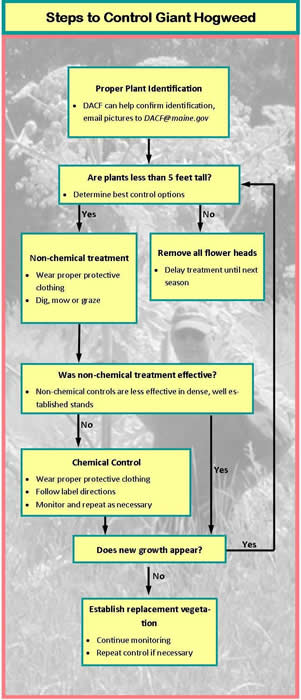DACF Home → Bureaus & Programs → Bureau of Agriculture → Division of Animal and Plant Health → Horticulture Program → Giant Hogweed
Giant Hogweed: Control and Safety Information
Giant Hogweed, Heracleum mantegazzianum is found sporadically throughout Maine, but is not a common plant. Several plants that pose no threat are often confused with giant hogweed. It is important to accurately identify plants before taking any control measures. Giant Hogweed Identification Information
Use Caution Around this Plant
Giant hogweed sap contains several photo-sensitizing compounds. When skin comes in contact with plant sap and is exposed to sunlight, burns, blisters or a rash may develop. Initial contact with plant sap is painless with the painful rash appearing sometime after exposure.
If you handle this plant be careful not to come into contact with sap from broken stems, leaves or other plant parts. Wear protective clothing made of water-resistant materials that covers as much skin as possible:
- wear gloves,
- long sleeves,
- long pants and
- eye protection.
If skin is exposed to giant hogweed sap:
- thoroughly wash exposed skin with soap and water,
- keep exposed skin protected from direct sunlight for at least 48 hours,
- if a rash develops, consult a medical professional
If eyes come in contact with sap:
- consult with a medical professional
Control Information
 Control of giant hogweed is the responsibility of the property owner.
Controlling giant hogweed takes persistence and repeated application of control measures. Giant hogweed seed can remain dormant in the soil for years, It is critical to monitor infested sites often to control any new plants that appear. Eradication is not achieved until regeneration of new plants from seed ceases. A delay or stop in management allows plants to quickly re-establish which may set you back years in the eradication process.
Control of giant hogweed is the responsibility of the property owner.
Controlling giant hogweed takes persistence and repeated application of control measures. Giant hogweed seed can remain dormant in the soil for years, It is critical to monitor infested sites often to control any new plants that appear. Eradication is not achieved until regeneration of new plants from seed ceases. A delay or stop in management allows plants to quickly re-establish which may set you back years in the eradication process.
For all control methods:
- Control options are best performed when plants are small, before they reach 5 feet tall.
- Prevent introduction into new areas by not moving plants or soil contaminated with seeds.
- Prevent plants from setting seed by removing flower heads.
- Control new, smaller infestations first before the seed bank has a chance to establish
- After removing giant hogweed plants, establish replacement vegetation to prevent soil erosion, provide competition for any re-sprouting giant hogweed plants and prevent the establishment of other invasive weeds.
- Continue to monitor sites for giant hogweed as the seed may remain viable in the soil for a number of years.
Non-Chemical Control Options
Non-chemical controls may not be practical for large, dense stands of giant hogweed. These controls are most effective when preventing seedling growth or when used in combination with a chemical control.
- Digging - Digging is the most effective non-chemical control. Cut plants below ground level removing as much of the taproot as possible, to discourage re-growth. For greatest control repeat every 1 to 2 weeks in the spring until plants reach 5 feet tall. Monitoring and persistence are needed to ensure that all plants are found and removed. Be patient, this method takes time, but is effective in small plots
- Mowing - Mowing or cutting plants above the ground level is not as effective as digging because it can encourage vigorous new growth from the root system. However, with repeated cuttings the roots will begin to starve and weaken. Vigilance is needed to prevent new shoots from becoming mature flowering plants. Be aware that skin and eye protection are critical when mowing or cutting. Mowers and string trimmers release sap from the foliage and stems that can end up on your skin.
- Grazing - Grazing by cattle, sheep and other livestock that are unaffected by hogweed sap will help in a control effort. Trampling and feeding by these animals will weaken plants, but most often the damage only suppresses growth and does not destroy plants.
Chemical control
- If possible, hire a professional pesticide applicator to apply an herbicide. Board of Pesticides Control
- Always read and follow all label directions.
- repeated applications will be necessary to control new plants sprouting from seeds in the soil and any larger plants that did not completely die from previous applications
- Giant hogweed is susceptible to the herbicides glyphosate and triclopyr
For more information on the control of giant hogweed refer to the Giant Hogweed Best Management Practices Manual (PDF 3MB).